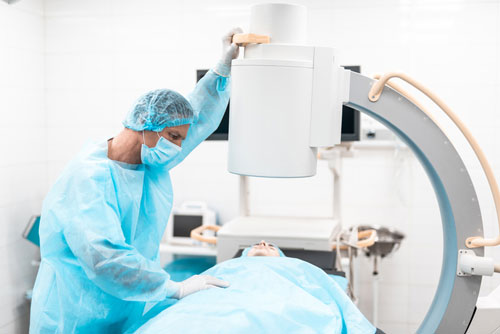X-rays…CT scans…PET scans…mammograms…fluoroscopy…
You’ve had a least some of these medical imaging procedures done to you. And the chances are good that you’ve had them done many times.
Doctors often order imaging tests routinely when trying to diagnose an illness or determine its severity.
We’ve known for a long time that the radiation exposure from these tests raises cancer risk. But doctors routinely warned us that the danger was slight. A new study shows that’s not true.
The research was reported in the journal JNCI Cancer Spectrum. Scientists analyzed health data that covered a 13-year period from more than 56,000 cancer patients.[1]
CT scans were linked to a higher risk of leukemia and thyroid cancer. CT scans were also linked to a three-fold increased risk of non-Hodgkin lymphoma.
CT (computerized tomography) scans are made up of numerous X-ray images taken from different angles around your body. That means they carry a big dose of radiation.
Professor Yu-Hsuan Joni Shao was one of the study authors. He said the “increased numbers of people undergoing CT scans have become a public health issue.”[2]
The worst part is that your risk is cumulative. The more of these tests you have over your lifetime, the greater your chances of getting cancer. But your doctor has no idea how many radiation-emitting tests you’ve had, so they continue to pile them on.
Know How Much Radiation You’re Getting
The following chart shows roughly the amount of radiation you get from
various procedures. Doses are approximate.* They are measured in millisieverts (mSv).
| Procedure | Average effective dose (mSv) | |
| Bone density test+ | 0.001 | |
| X-ray, arm or leg | 0.001 | |
| X-ray, panoramic dental | 0.01 | |
| X-ray, chest | 0.1 | |
| X-ray, abdominal | 0.7 | |
| Mammogram | 0.4 | |
| X-ray, lumbar spine | 1.5 | |
| CT, head | 2 | |
| CT, cardiac for calcium scoring | 3 | |
| Nuclear imaging, bone scan | 6.3 | |
| CT, spine | 6 | |
| CT, pelvis | 6 | |
| CT, chest | 7 | |
| CT, abdomen | 8 | |
| CT, colonoscopy | 10 | |
| CT, angiogram | 16 | |
| CT, whole body | variable | |
| Nuclear imaging, cardiac stress test | 40.7 | |
| *The actual radiation exposure depends on many things, including the device itself, the duration of the scan, your size, and the sensitivity of the tissue being targeted. +Dual energy x-ray absorptiometry, or DXA. | ||
| Source: Mettler FA, et al. “Effective Doses in Radiology and Diagnostic Nuclear Medicine: A Catalog,” Radiology (July 2008), Vol. 248, pp. 254–63. |
5 Ways to Minimize Your Radiation Exposure
There are several things you can do to help keep radiation exposure to the lowest possible level…
- Ask your doctor if an X-ray is necessary. As a patient, you have every right to ask questions. Ask your doctor exactly what the purpose of the X-ray is. Ask if there are alternative procedures that might serve the same purpose without exposing you to radiation.
- Don’t let your dentist give you X-rays every year. People with healthy teeth and gums can go at least three years between X-rays. A 2012 Yale University study found a link between dental X-rays and brain cancer.[3] [4]
- Ask if an MRI is an option. MRI (magnetic resonance imaging) uses a magnetic field instead of radiation to image your body. MRI does not carry an increased risk of cancer. Sometimes an MRI can be used in place of CT scans. If you have metal in your body—such as in a pacemaker or orthopedic hardware—you may not be able to use MRI. That’s because the magnetic field can pull on metal parts, causing them to move out of place.[5]
- Ask for a protective shield. The technician will likely put a shield on you to protect the parts of your body that don’t need to be X-rayed. But make sure this isn’t overlooked. And make sure the shield provides good coverage of areas not being imaged.
- Track your X-ray history. You probably keep a list of your medications. You should do the same thing with your imaging records. Whenever you get an X-ray or anything that involves radiation exposure, write down the date, the type of procedure, the doctor who prescribed it, and where the images are kept. Refer to the information in the future so you can avoid getting X-rays taken that you’ve already had.
Radiation imaging is an important diagnostic tool. But it should be used sparingly because of the cancer risk involved. Don’t let your doctor raise that risk unnecessarily.
Editor’s Note: If you’re worried about cancer, you need to read our monthly journal, Independent Healing. It’s your best source for unbiased, evidence-based medical advice. Discover The Cancer Kill Code. It’s a secret natural trigger that detonates cancer’s self-destruct button.
Related Articles
Is Wi-Fi Radiation the Reason You Feel Lousy?
7 Ways to Protect Yourself from Cellphone Radiation
This Spice
Stops Cancer, Study Finds
Like this Article? Forward this article here or Share on Facebook.
[1]https://academic.oup.com/jncics/advance-article/doi/10.1093/jncics/pkz072/5572999
[2]https://www.eurekalert.org/pub_releases/2019-11/oupu-rfc111519.php
[3] https://well.blogs.nytimes.com/2015/12/15/ask-well-how-often-should-you-get-dental-x-rays/
[4] https://www.ncbi.nlm.nih.gov/pubmed/22492363
[5] https://www.medicinenet.com/ct_scan_vs_mri/article.htm

